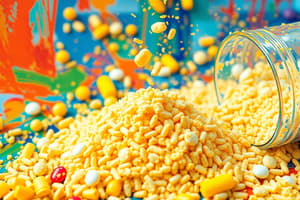Podcast
Questions and Answers
Dry granulation is the process of powder granulation by compression without using ______ or solvent.
Dry granulation is the process of powder granulation by compression without using ______ or solvent.
heat
The principle of dry granulation is summarized by forming a compact of the material by slight compression followed by ______ of the compact.
The principle of dry granulation is summarized by forming a compact of the material by slight compression followed by ______ of the compact.
milling
The method used for dry granulation includes slugging technique and ______ compaction technique.
The method used for dry granulation includes slugging technique and ______ compaction technique.
roller
In the slugging method, the resulting tablets called slugs are then ______ to yield granules.
In the slugging method, the resulting tablets called slugs are then ______ to yield granules.
A slug is a large flat tablet that contains half the amount of ______ to enhance powder flow during slugging.
A slug is a large flat tablet that contains half the amount of ______ to enhance powder flow during slugging.
In the roller compaction method, two rolls rotate against each other to increase the ______ of powder.
In the roller compaction method, two rolls rotate against each other to increase the ______ of powder.
One advantage of dry granulation is that it requires less ______ and space compared to wet granulation.
One advantage of dry granulation is that it requires less ______ and space compared to wet granulation.
Dry granulation is especially useful for heat and/or moisture sensitive ______.
Dry granulation is especially useful for heat and/or moisture sensitive ______.
Dry granulation ensures uniform distribution of active ingredients, preventing ______ of particles.
Dry granulation ensures uniform distribution of active ingredients, preventing ______ of particles.
The binder used in dry granulation method is in powder form, leading to rapid ______ compared to wet granulation.
The binder used in dry granulation method is in powder form, leading to rapid ______ compared to wet granulation.
Flashcards
Dry Granulation
Dry Granulation
A powder granulation method using compression without heat or solvents.
Dry Granulation Purpose
Dry Granulation Purpose
Used for drugs difficult to compress directly or sensitive to heat/moisture.
Slugging Technique
Slugging Technique
Pre-compressing powder mixture into large tablets(slugs), then milling them into granules.
Slug
Slug
Signup and view all the flashcards
Roller Compaction
Roller Compaction
Signup and view all the flashcards
Roller Compaction Advantage
Roller Compaction Advantage
Signup and view all the flashcards
Dry Granulation Advantage (Heat/Moisture sensitivity)
Dry Granulation Advantage (Heat/Moisture sensitivity)
Signup and view all the flashcards
Dry Granulation Advantage (Disintegration)
Dry Granulation Advantage (Disintegration)
Signup and view all the flashcards
Dry Granulation Advantage (Distribution)
Dry Granulation Advantage (Distribution)
Signup and view all the flashcards
Dry Granulation Advantage (Equipment)
Dry Granulation Advantage (Equipment)
Signup and view all the flashcards
Study Notes
Dry Granulation
- Dry granulation is a powder granulation method using compression without heat or solvents.
- This technique is used when drugs can't be directly compressed (e.g., high dose, flowability issues) and are heat/moisture sensitive.
- Cohesive properties of the active ingredient or diluent are essential.
Methods of Dry Granulation
-
Slugging Technique:
- Ingredients are weighed and mixed.
- The powder mixture is compressed (slugged) into large tablets (slugs).
- Slugs are then milled into granules.
- Slugs are large, flat tablets or pellets, approximately one inch in diameter.
- Half the typical lubricant amount is added during slugging to improve flow and prevent sticking to the die.
-
Roller Compaction Technique:
- Two rotating rollers increase powder density by pressing it.
- This creates a thin sheet or ribbon, similar to a slug.
- The sheet is screened to produce uniform granules.
- This method handles large amounts of material rapidly.
Advantages of Dry Granulation
- Requires less equipment and space than wet granulation.
- Suitable for heat/moisture-sensitive drugs (e.g., effervescent tablets).
- Rapid disintegration due to the use of powder binder, resulting in a faster disintegration rate.
- Improves dissolution for anhydrous, soluble compounds.
- Ensures uniform distribution of active ingredients (prevents segregation).
Disadvantages of Dry Granulation
- Requires specialized equipment for granule production.
- Dust generation from the dry process can lead to cross-contamination.
- Dissolution issues can occur for insoluble drugs.
Studying That Suits You
Use AI to generate personalized quizzes and flashcards to suit your learning preferences.




